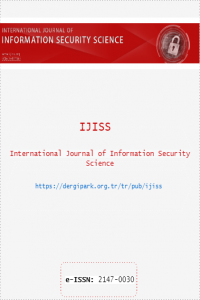On the Construction of Low-latency 32 × 32 Binary MDS Matrices from GHadamard Matrices
On the Construction of Low-latency 32 × 32 Binary MDS Matrices from GHadamard Matrices
___
- S. Li, S. Sun, C. Li, Z. Wei and L. Hu, Constructing Lowlatency Involutory MDS matrices with Lightweight Circuits, IACR Transactions on Symmetric Cryptology, vol. 1, pp. 84–117, 2019.
- C.E. Shannon, Communication theory of secrecy systems, Bell Syst. Tech. J., vol. 28, pp. 656-715, 1949.
- M.K. Pehlivanoğlu and E.B. Kavun, On the Design of Maximum Distance Separable Diffusion Layers of Cryptographic Block Ciphers, in CyberSecurity and Defense, Ankara: Nobel Academic Publishing Education Consultancy, pp. 295-325, 2020.
- J. Daemen and V. Rijmen, The Design of Rijndael: AES-The Advanced Encryption Standard, 1st ed., Springer-Verlag Berlin Heidelber, pp. 1-7, 2002.
- J. Guo, T. Peyrin and A. Poschmann, The PHOTON Family of Lightweight Hash Functions, in Advances in Cryptology – CRYPTO 2011, vol. 6841, pp. 222-239, 2011.
- J. Guo, T. Peyrin, A. Poschmann and M. Robshaw, The LED Block Cipher, in Cryptographic Hardware and Embedded Systems – CHES 2011, vol. 6917, pp. 326-341, 2011.
- P.S.L.M. Barreto and V. Rijmen, The Khazad Legacy-Level Block Cipher, First Open NESSIE Workshop 2000, Leuven, Belgium, 2000.
- K. Shibutani, T. Isobe, H. Hiwatari and et al., Piccolo: An Ultra-Lightweight Blockcipher, in Cryptographic Hardware and Embedded Systems – CHES 2011, vol. 6917, pp. 342-357, 2011.
- C. Paar, Optimized Arithmetic for Reed-Solomon Encoders, 1997 IEEE International Symposium on Information Theory, pp. 250, 1997.
- J. Boyar and R. Peralta, A New Combinational Logic Minimization Technique with Applications to Cryptology, SEA 2010, LNCS, vol. 6049, pp. 178-189, 2010.
- J. Boyar, P. Matthews and R. Peralta, Logic Minimization Techniques with Applications to Cryptology, Journal of Cryptology, vol. 26, pp. 280–312, 2013.
- J. Boyar, M. G. Find and R. Peralta, Low-Depth, Low-Size Circuits for Cryptographic Applications, BFA 2017. 2017.
- J. Boyar, M. G. Find and R. Peralta, Small Low-depth Circuits for Cryptographic Applications, Cryptography and Communications, vol. 11, no. 1, pp. 109–127, 2019.
- Q.Q. Tan and T. Peyrin, Improved Heuristics for Short Linear Programs, Cryptology ePrint Archive, Report 2019/847, 2019.
- C. Wolf, Yosys Open Synthesis Suite, http://www.clifford.at/yosys/, Accessed: November 10, 2021.
- R.K. Brayton and A. Mishchenko, ABC: An Academic Industrial Strength Verification Tool, CAV 2010, vol. 6174, pp. 24–40, 2010.
- K. Stoffelen, Optimizing S-Box Implementations for Several Criteria Using SAT Solvers, FSE 2016, LNCS, vol. 9783, pp. 140–160, 2016.
- J. Jean, T. Peyrin, S.M. Sim and J. Tourteaux, Optimizing Implementations of Lightweight Building Blocks, IACR Trans. Symmetric Cryptol., vol. 2017, no. 4, pp. 130–168, 2017.
- S. Duval and G. Leurent, MDS Matrices with Lightweight Circuits. IACR Transactions on Symmetric Cryptology, vol. 2018(2), pp. 48-78, 2018.
- M.K. Pehlivanoğlu, M.T. Sakallı, S. Akleylek, N. Duru and V. Rijmen, Generalisation of Hadamard Matrix to Generate Involutory MDS Matrices for Lightweight Cryptography, IET Information Security, vol. 12, pp. 348–355, 2018.
- G.G. Guzel, M.T. Sakallı, S. Akleylek, V. Rijmen and Y. C¸ engellenmis¸ A New Matrix Form to Generate All 3 × 3 Involutory MDS Matrices over F2m , Information Processing Letters, vol. 147, pp. 61-68, 2019.
- M.T. Sakallı, S. Akleylek, K. Akkanat and V. Rijmen, On the automorphisms and isomorphisms of MDS matrices and their efficient implementations, Turkish Journal of Electrical Computer Sciences, vol.28, no. 1, pp. 275-287, 2020.
- M.K. Pehlivanoğlu, https://github.com/mkurtpehlivanoglu/ 32x32 binarymatrices.git, Accessed: November 11, 2021.
- T. Kranz, G. Leander, K. Stoffelen and F. Wiemer, Shorterlinear straight-line programs for MDS matrices, IACR Trans. Symmetric Cryptol., vol. 2017(4), pp. 188–211, 2017. 118
- Yayın Aralığı: Yılda 4 Sayı
- Başlangıç: 2012
- Yayıncı: Şeref SAĞIROĞLU
A Survey on Security Requirements, Threats and Protocols in Industrial Internet of Things
An Exploratory Analysis of Leaked Facebook Data: A Case of Turkish Users
On the Construction of Low-latency 32 × 32 Binary MDS Matrices from GHadamard Matrices
Meltem KURT PEHLİVANOĞLU, Fatma BÜYÜKSARAÇOĞLU SAKALLI, Muharrem Tolga SAKALLI
